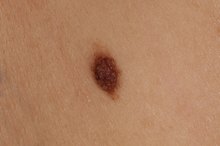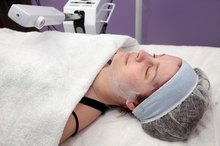A Chemical Peel for Enlarged Pores
A chemical peel is used to remove the outer damaged layers of the epidermis with an acidic solution to improve your skin’s appearance and texture. According to the American Academy of Dermatology, a chemical peel cannot change the size of your pores; however, it can make your pores less noticeable 12. A dermatologist or plastic surgeon can determine the type of peel that will benefit you most at your initial consultation.
Pores
Although pores can seem like a cosmetic burden, they are necessary since they allow hair grown and allow protective oils to reach the skin’s surface. Causes of enlarged pores include hereditary, sun damage, blackheads and a lack of appropriate exfoliation. Chemical peels can be helpful in treating these conditions that cause the appearance of pores to be enhanced.
Peels
What Are the Treatments for Excessive Swelling From a Chemical Peel?
Learn More
According to the American Society of Plastic Surgeons, or ASPS, the solutions used for chemical peels are phenol, trichloracetic acid (TCA) or alpha hydroxy acid (AHA) 12. The formula used can be adjusted to meet the needs of the patient. AHA peels are mild formulas that may require a series of peels before the desired results are met. According to the ASPS, glycolic acid is an AHA and this can be mixed with facial washes to improve your skin’s texture. TCA peels are medium depth peels. A TCA peel can be adjusted to remove superficial layers of the skin or remove deeper layers. A phenol peel is a strong “deep peel” that will remove the deepest layers of epidermal damage.
- According to the American Society of Plastic Surgeons, or ASPS, the solutions used for chemical peels are phenol, trichloracetic acid (TCA) or alpha hydroxy acid (AHA) 1.
- According to the ASPS, glycolic acid is an AHA and this can be mixed with facial washes to improve your skin’s texture.
Considerations
During most chemical peels, you may experience a warm sensation that last approximately 10 minutes. However, a deeper peel may be painful and require a pain medication during and following the procedure. AHA and superficial TCA peels have minimal recovery time. These milder formulas may cause short-term redness, irritation and stinging. According to the ASPS, you should have someone drive you after a phenol or deep TCA peel. These deeper peels will make your skin very red and in some cases there will be swelling and discomfort.
- During most chemical peels, you may experience a warm sensation that last approximately 10 minutes.
- However, a deeper peel may be painful and require a pain medication during and following the procedure.
Warning
AmLactin Lotion Side Effects
Learn More
Not all states require chemical peels to be administered by professionals with advanced medical degrees. To avoid complications, have chemical peels performed by licensed professionals, especially phenol peels. According to ASPS, a phenol peel can cause the skin to lose its ability to tan and there is a risk for patients with a history of heart disease.
Prevention
Once your chemical peel or peels have been completed, you will need to make adjustments to your skin care regimen to reduce the risk of increasing the visibility of your pores. Wash your face twice per day with an oil-free cleanser that targets acne prone skin to decrease the amount of blackheads, debris and oil that clog and enlarge your pores. You skin will be sensitive after a chemical peel, so be sure to wear a sunscreen with a minimum sun protection factor, or SPF, of 30 and continue wearing sunscreen daily to prevent enlarged pores. Once your face has fully healed from a chemical peel, begin exfoliating twice per week to remove dead skin cells that surround pores and make pores appear larger.
- Once your chemical peel or peels have been completed, you will need to make adjustments to your skin care regimen to reduce the risk of increasing the visibility of your pores.
Related Articles
References
- American Society of Plastic Surgeons: Chemical Peel
- American Academy of Dermatology: Chemical Peels
- O'connor AA, Lowe PM, Shumack S, Lim AC. Chemical peels: a review of current practice. Australas J Dermatol. 2018;59(3):171-181. doi:10.1111/ajd.12715
- Castillo DE, Keri JE. Chemical peels in the treatment of acne: patient selection and perspectives. Clin Cosmet Investig Dermatol. 2018;11:365–372. doi:10.2147/CCID.S137788
- Soleymani T, Lanoue J, Rahman Z. A practical approach to chemical peels: a review of fundamentals and step-by-step algorithmic protocol for treatment. J Clin Aesthet Dermatol. 2018;11(8):21–28.
- Cleveland Clinic. Chemical peels: what to expect.
- Cleveland Clinic. Chemical peels: how to prepare.
- Stanford Healthcare. Techniques: our approach to chemical skin peels.
- Cleveland Clinic. What results can I expect?.
Writer Bio
Melissa McNamara is a certified personal trainer who holds a Bachelor of Arts in journalism and communication studies from the University of Iowa. She writes for various health and fitness publications while working toward a Bachelor of Science in nursing.









